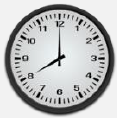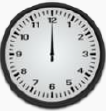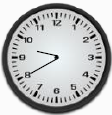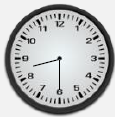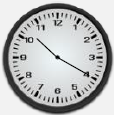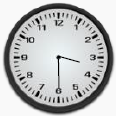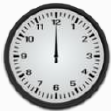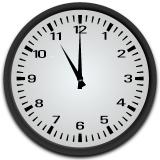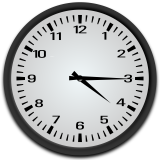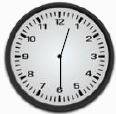2.4: Quelle heure est-il ?
( \newcommand{\kernel}{\mathrm{null}\,}\)
In this section, you will learn how to talk about the time.
Listen to the audio clips that follow on this page to hear the French pronunciation of vocabulary and examples presented.
On étudie !
 "This work" by pixabay.com is in the Public Domain, CC0
"This work" by pixabay.com is in the Public Domain, CC0| Question | Réponses | Vocabulaire |
|---|---|---|
|
Quelle heure est-il ? |
Il est # heure(s) # Il est # heure(s) et quart Il est # heure(s) et demi(e) Il est # heure(s) moins (le) quart |
du matin de l'après-midi du soir |
Pour en savoir plus.
- In English, we often count the minutes until the next hour (e.g., ten 'til eight), but in French we count backwards from the next hour (e.g., huit heures moins dix [eight minus ten])
- For formal scheduling (ie: transportation, work, entertainment schedules) the 24-hour system (or military time) is commonly used. The terms “demi(e)”, “et quart” and “moins le quart” are not used in that system. Pour en savoir plus sur l'heure officielle.
Practice telling time: Quelle heure est-il ?
| Le matin | L'après-midi | Le soir, la nuit |
|---|---|---|
|
Il est huit heures. |
Il est midi. |
Il est dix heures moins vingt. |
|
Il est huit heures et demie. |
Il est une heure moins cinq. |
Il est dix heures vingt. |
|
Il est neuf heures moins le quart. |
Il est trois heures et demie. |
Il est minuit. |
|
Il est onze heures. |
Il est quatre heures et quart. |
Il est minuit et demi. |
"This work" by is in the Public Domain, CC0
This video will help you practice telling time.
You can listen and repeat.
You can watch this video tutorial to review Quelle heure est-il ?: What Time Is It?
Here is a worksheet to practice telling time: L’heure et l’horloge
On pratique !
Activité A
Quelle heure est-il ? Write down the times shown in each clock. Spell out every number.
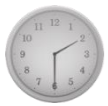 Il est deux heures et demie. "This work" by pixabay.com is in the Public Domain, CC0
Il est deux heures et demie. "This work" by pixabay.com is in the Public Domain, CC0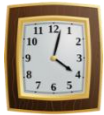 ________. "This work" by pixabay.com is in the Public Domain, CC0
________. "This work" by pixabay.com is in the Public Domain, CC0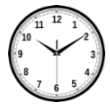 ________. "This work" by pixabay.com is in the Public Domain, CC0
________. "This work" by pixabay.com is in the Public Domain, CC0 ________. "This work" by pixabay.com is in the Public Domain, CC0
________. "This work" by pixabay.com is in the Public Domain, CC0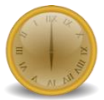 ________. "This work" by pixabay.com is in the Public Domain, CC0
________. "This work" by pixabay.com is in the Public Domain, CC0 ________. "This work" by pixabay.com is in the Public Domain, CC0
________. "This work" by pixabay.com is in the Public Domain, CC0
Activité B
Quelle heure est-il ? Il est midi. Listen to this song and sing along: Il est midi.
Transcription:
Quelle heure est-il ? Il est midi.
Qui te l’a dit ? La p’tite souris.
Où donc est-il ? Dans la chapelle
Et qu’y fait-elle ? De la dentelle.
Pour qui ? Pour les dames de Paris.
Qui portent des souliers gris.
Activité C
Dialogue. Quelle heure est-il ? Politely ask your friends what time it is based on the model. Have each person answer with a different time.
Modèle :
Étudiant(e) 1 : Quelle heure est-il, s’il te plaît ?
Étudiant(e) 2 : Il est neuf heures moins dix.
Étudiant(e) 1 : Merci.
Étudiant(e) 2 : De rien.
Activité D
Dialogue. In pairs, look at the times given below and take turns asking each other the time according to the modèle:
Modèle :
6:00 P.M. ➔
Étudiant(e) 1 : Quelle heure est-il ?
Étudiant(e) 2 : Il est six heures du soir.
- 8:35 am
- 11:15 am
- 10:30 pm
- 12:00 am
- 1:20 pm
- 3:55 pm
- 7:45 am
- 12:30 pm
Activité E
Take a piece of paper, draw a clock on it. Go around the room and ask a classmate what time it is. Show them your clock and see if they can say in French what time it is. Then switch your clock with your classmate’s clock and go up to another classmate and do the same thing.
On approfondit !
Use the following resources to type accents and/or search for words:
- Accents: ç, à, é, è, â, ê, î, ô, û, ù, ë, ï, ü
- Dictionnaire français-anglais


